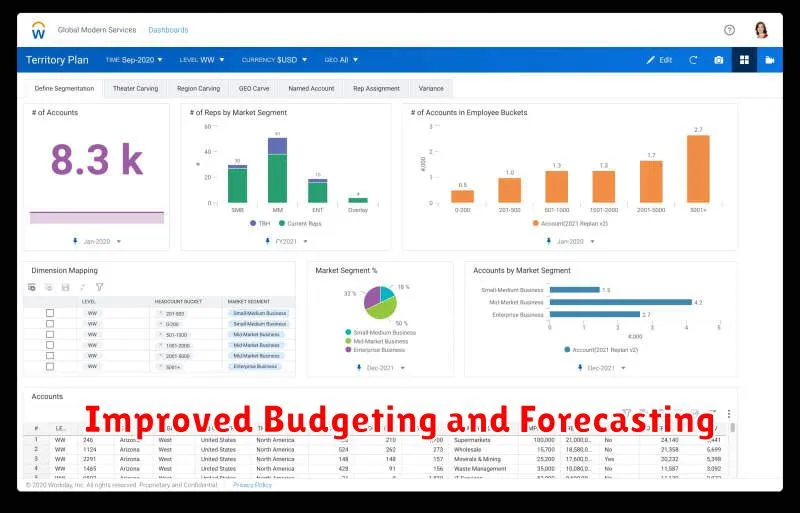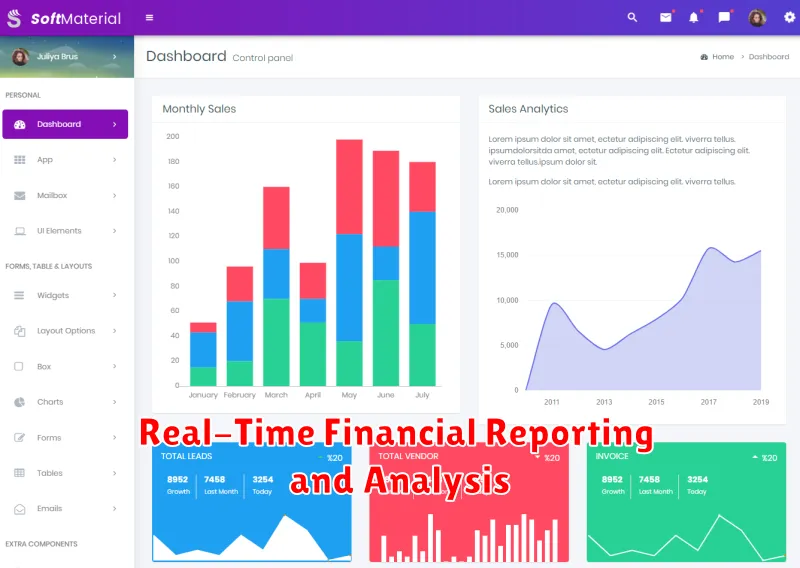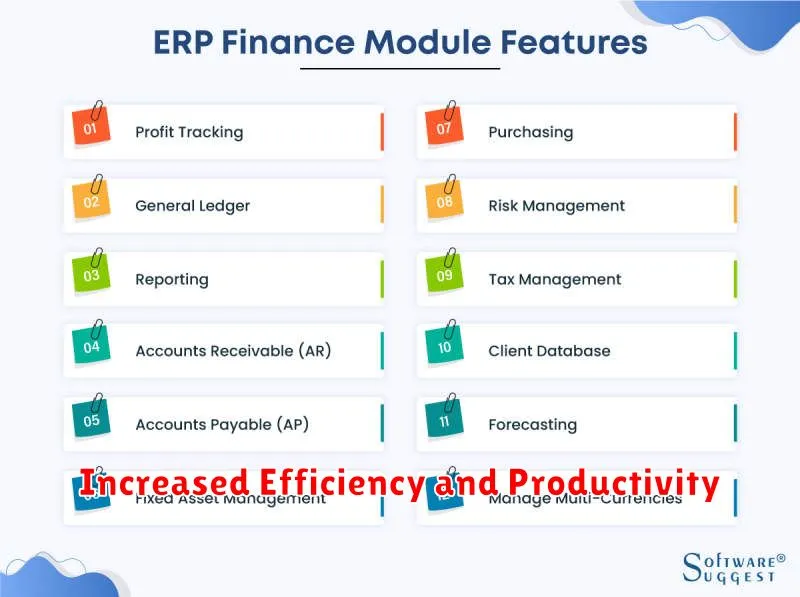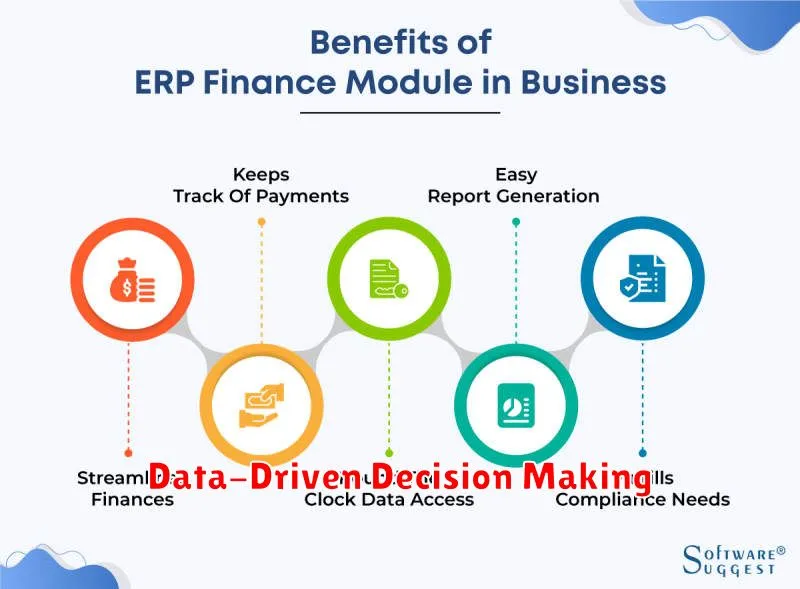Implementing the right ERP software can be a game-changer for your business, particularly when it comes to financial planning. With an ERP system, you gain access to a centralized platform that integrates all your crucial financial data, streamlining your processes and providing valuable insights. This article delves into the key advantages of using ERP software for financial planning, helping you understand how it can boost your financial efficiency, improve decision-making, and propel your business towards greater success.
The Importance of Streamlined Financial Planning
In today’s complex and ever-changing economic landscape, effective financial planning is paramount for individuals and families alike. A streamlined approach to financial planning can provide numerous benefits, ensuring financial security, peace of mind, and the ability to achieve long-term financial goals. This article will delve into the significance of streamlined financial planning and outline its key components.
One of the primary benefits of streamlined financial planning is its ability to reduce stress and anxiety. By having a clear roadmap for managing finances, individuals can eliminate uncertainty and gain control over their financial future. A well-defined plan outlines spending habits, savings goals, and investment strategies, allowing individuals to track their progress and make informed decisions.
Streamlined financial planning also plays a crucial role in achieving financial goals. Whether it’s buying a home, saving for retirement, or funding a child’s education, a comprehensive plan helps individuals prioritize their goals and develop a realistic timeline for achieving them. By setting specific, measurable, achievable, relevant, and time-bound (SMART) goals, individuals can stay motivated and make consistent progress.
Furthermore, a streamlined approach to financial planning facilitates efficient allocation of resources. By identifying spending patterns and prioritizing essential expenses, individuals can optimize their financial resources and make informed decisions about where to allocate their money. This process can help reduce unnecessary spending and maximize savings potential.
In conclusion, streamlined financial planning is an essential tool for individuals seeking to achieve financial security and peace of mind. By reducing stress, achieving financial goals, and optimizing resource allocation, a well-structured plan empowers individuals to make informed financial decisions and navigate the complexities of modern life.
Centralized Financial Data Management

In today’s complex business environment, managing financial data effectively is crucial for informed decision-making, operational efficiency, and overall success. A centralized approach to financial data management offers numerous advantages, streamlining processes, enhancing accuracy, and providing a comprehensive view of an organization’s financial health.
Key Benefits of Centralized Financial Data Management
A centralized financial data management system provides a single source of truth, eliminating data silos and inconsistencies. This enables:
- Improved Data Accuracy: By consolidating data from various sources, the risk of errors and inconsistencies is reduced, ensuring data integrity and reliability.
- Enhanced Reporting and Analytics: Accessing data from a centralized system facilitates the creation of insightful reports and analyses, providing a holistic understanding of financial performance.
- Streamlined Processes: Automating data capture, validation, and reporting simplifies processes, reducing manual effort and eliminating potential bottlenecks.
- Better Collaboration and Communication: A centralized system promotes collaboration among departments, fostering better communication and understanding of financial data across the organization.
- Increased Efficiency: By eliminating redundancy and streamlining workflows, centralized financial data management improves operational efficiency and productivity.
- Reduced Costs: Centralized data management reduces the need for multiple databases and software licenses, leading to cost savings and improved return on investment.
Implementing Centralized Financial Data Management
Implementing a centralized financial data management system involves a strategic approach and careful planning. Key steps include:
- Defining Data Requirements: Identify the specific data elements and metrics that are essential for decision-making and reporting.
- Selecting the Right Technology: Choose a data management platform that meets the organization’s specific needs, including data storage, integration, security, and analytics capabilities.
- Data Integration and Cleansing: Integrate data from different sources and ensure data quality through cleansing and standardization processes.
- User Training and Adoption: Provide comprehensive training to ensure users are proficient in accessing and utilizing the centralized system.
- Continuous Monitoring and Improvement: Regularly monitor the system’s performance, identify areas for improvement, and make necessary adjustments to optimize its effectiveness.
Conclusion
Centralized financial data management is essential for businesses of all sizes seeking to optimize their financial processes, improve decision-making, and gain a competitive advantage. By embracing a centralized approach, organizations can unlock the power of their data, drive efficiency, and achieve their financial goals.
Improved Budgeting and Forecasting

Budgeting and forecasting are essential for any business, regardless of size. They provide a roadmap for financial success, helping businesses to make informed decisions about spending, investment, and resource allocation. However, traditional budgeting methods often fall short, relying on static projections and failing to account for the dynamic nature of the business environment. This can lead to inaccurate forecasts, budget overruns, and missed opportunities.
To overcome these challenges, businesses are turning to advanced budgeting and forecasting techniques that leverage data analytics, predictive modeling, and real-time insights. These techniques enable businesses to:
- Improve accuracy and precision of forecasts by analyzing historical data, market trends, and economic indicators.
- Gain deeper insights into spending patterns, identifying areas of potential cost savings and optimization.
- Create more dynamic and flexible budgets that adapt to changing market conditions and unforeseen events.
- Enhance collaboration and communication among departments by providing a centralized platform for budget planning, tracking, and reporting.
By embracing these advanced methods, businesses can achieve a significant competitive advantage, enabling them to make more strategic decisions, optimize resource allocation, and drive sustainable growth.
Real-Time Financial Reporting and Analysis

In today’s fast-paced business environment, timely and accurate financial information is crucial for informed decision-making. Real-time financial reporting and analysis empower businesses to gain insights into their financial performance and make strategic adjustments on the fly. This article will delve into the benefits, challenges, and key aspects of real-time financial reporting and analysis.
Benefits of Real-Time Financial Reporting and Analysis
Real-time financial reporting offers numerous advantages for businesses of all sizes:
- Enhanced Visibility and Transparency: Real-time data provides a comprehensive view of financial performance, enabling businesses to track key metrics, identify trends, and understand the impact of various decisions.
- Improved Decision-Making: With access to up-to-the-minute financial information, managers can make more informed and timely decisions, minimizing risks and maximizing opportunities.
- Increased Efficiency and Productivity: Automation and real-time data processing streamline financial processes, reducing manual efforts and freeing up time for strategic analysis.
- Enhanced Risk Management: Real-time monitoring allows businesses to identify potential financial risks early on and take proactive measures to mitigate them.
- Improved Customer Service: Real-time data can be used to analyze customer behavior and tailor services to their needs, leading to improved customer satisfaction.
Challenges of Real-Time Financial Reporting and Analysis
While real-time financial reporting offers significant advantages, it also presents certain challenges:
- Data Integrity and Accuracy: Ensuring the accuracy and reliability of real-time data is paramount. Robust data governance and quality control measures are essential.
- System Integration and Compatibility: Integrating disparate financial systems and ensuring data compatibility can be complex and require significant technical expertise.
- Security and Compliance: Protecting sensitive financial data from unauthorized access and ensuring compliance with regulations is critical.
- Cost and Infrastructure: Implementing real-time financial reporting solutions can involve significant investments in technology and infrastructure.
- Talent and Expertise: Businesses need skilled professionals with expertise in financial analysis, data interpretation, and technology to effectively utilize real-time financial data.
Key Aspects of Real-Time Financial Reporting and Analysis
Successful implementation of real-time financial reporting and analysis requires careful consideration of the following aspects:
- Data Sources and Collection: Identifying relevant data sources, establishing efficient data collection methods, and ensuring data quality are crucial.
- Data Processing and Analysis: Utilizing advanced analytics tools and techniques to transform raw data into actionable insights is essential.
- Reporting and Visualization: Presenting financial information in a clear, concise, and visually appealing manner is vital for effective communication.
- User Access and Permissions: Defining user roles, access levels, and security measures to ensure data confidentiality and integrity is important.
- Continuous Improvement: Regularly evaluating and refining the real-time financial reporting and analysis process to optimize its effectiveness is crucial.
Conclusion
Real-time financial reporting and analysis is essential for businesses seeking to gain a competitive edge in today’s dynamic environment. By leveraging the power of real-time data, businesses can enhance decision-making, improve efficiency, and navigate market challenges with greater confidence. However, successful implementation requires careful planning, robust technology, and a skilled team to overcome the challenges and unlock the full potential of real-time financial insights.
Enhanced Collaboration and Communication
In today’s interconnected world, effective collaboration and communication are paramount to achieving success. Whether it’s within a team, between departments, or with external stakeholders, seamless information sharing and joint efforts are essential for optimal outcomes.
Technology plays a crucial role in enhancing collaboration and communication. Advanced tools and platforms enable real-time communication, document sharing, and task management, bridging geographical and physical barriers. Collaboration software, video conferencing applications, and project management platforms have transformed the way we work together.
One of the key benefits of enhanced collaboration is increased productivity. When teams can work together seamlessly, tasks can be completed faster and more efficiently. Shared understanding and real-time communication eliminate ambiguity and reduce the need for rework.
Another advantage is improved decision-making. Collaborative environments foster diverse perspectives and open dialogue, leading to more informed and well-rounded decisions. By pooling collective knowledge and expertise, teams can identify potential pitfalls and explore innovative solutions.
Enhanced collaboration also fosters a sense of community and belonging. When individuals feel connected and valued, they are more likely to be engaged and motivated. Collaboration provides opportunities for professional development, knowledge sharing, and the creation of a positive work environment.
In conclusion, effective collaboration and communication are essential for success in today’s dynamic business landscape. Technology has empowered us with powerful tools that can enhance productivity, decision-making, and team cohesion. By embracing these advancements and fostering a culture of collaboration, organizations can unlock their full potential and achieve remarkable results.
Reduced Risk and Improved Compliance
In today’s complex and ever-evolving business landscape, organizations face a multitude of risks that can jeopardize their operations, reputation, and financial stability. From cybersecurity threats to regulatory changes, the need for effective risk management and compliance programs has never been more critical.
By implementing robust risk management and compliance strategies, organizations can significantly reduce their exposure to potential threats, improve their operational efficiency, and enhance their overall performance. Here are some key benefits:
Reduced Risk Exposure
A well-defined risk management program helps organizations identify, assess, and mitigate potential risks before they escalate into significant problems. By proactively addressing vulnerabilities and implementing appropriate safeguards, businesses can significantly reduce their exposure to financial losses, legal liabilities, reputational damage, and operational disruptions.
Enhanced Compliance
Compliance with relevant laws, regulations, and industry standards is essential for any organization. Failure to comply can result in hefty fines, penalties, and legal actions. A comprehensive compliance program ensures that organizations adhere to all applicable rules and regulations, minimizing their risk of non-compliance and associated consequences.
Improved Decision-Making
By gaining a clear understanding of their risk landscape, organizations can make more informed and strategic decisions. Risk assessments provide valuable insights into potential threats and opportunities, enabling executives to allocate resources effectively and prioritize initiatives that align with their business objectives.
Enhanced Reputation
A strong commitment to risk management and compliance builds trust with stakeholders, including customers, investors, and employees. Demonstrating a proactive approach to risk mitigation and regulatory compliance enhances an organization’s reputation for reliability, integrity, and responsible business practices.
Increased Efficiency
By streamlining operations and eliminating unnecessary complexities, risk management and compliance programs can enhance organizational efficiency. By identifying and addressing inefficiencies, businesses can optimize their processes, reduce costs, and improve overall performance.
Conclusion
In today’s dynamic business environment, effective risk management and compliance are essential for organizational success. By implementing robust programs, organizations can minimize their exposure to threats, enhance their compliance posture, improve decision-making, and achieve their strategic goals.
Increased Efficiency and Productivity

In today’s fast-paced world, it’s more important than ever to find ways to increase efficiency and productivity. Whether you’re a student, a professional, or simply someone who wants to get more done, there are plenty of strategies you can use to improve your performance.
One key to increased efficiency is to prioritize your tasks. Identify the most important things that need to be accomplished and focus on those first. This can help you to avoid feeling overwhelmed and ensure that you’re making progress on the tasks that matter most.
Another important factor in productivity is to create a focused work environment. This means minimizing distractions and making sure you have the resources you need to succeed. Consider using noise-cancelling headphones, turning off notifications, or working in a dedicated workspace to minimize interruptions.
Finally, don’t forget the importance of taking breaks. Working for long periods without a break can lead to burnout and reduced productivity. Schedule regular breaks throughout your workday to give your mind and body a chance to rest. This will help you to return to your work feeling refreshed and more focused.
By implementing these strategies, you can significantly improve your efficiency and productivity. Remember that everyone works differently, so it’s important to find strategies that work best for you. With a little effort, you can achieve more in less time and live a more fulfilling life.
Data-Driven Decision Making

Data-driven decision making is a process of using data to inform business decisions. It involves collecting, analyzing, and interpreting data to gain insights that can be used to improve performance and achieve business goals. This approach is becoming increasingly important in today’s data-rich world, as businesses are constantly seeking ways to gain a competitive advantage.
The key benefits of data-driven decision making include:
- Improved decision quality: Data can provide objective insights that can help to reduce bias and improve decision-making.
- Increased efficiency: Data can be used to identify areas where processes can be improved and resources can be optimized.
- Enhanced customer experience: Data can be used to understand customer behavior and preferences, which can help businesses to provide more personalized and engaging experiences.
- Reduced risk: Data can be used to identify potential risks and opportunities, which can help businesses to make more informed decisions.
- Increased profitability: By making better decisions, businesses can increase their profitability and achieve their financial goals.
To successfully implement data-driven decision making, businesses need to:
- Establish a data strategy: This involves defining the business goals that data will be used to achieve and identifying the data sources that will be required.
- Invest in data infrastructure: This includes systems for data collection, storage, and analysis.
- Develop data skills: Businesses need employees who can collect, analyze, and interpret data effectively.
- Foster a data-driven culture: This means encouraging employees at all levels to use data to inform their decisions.
Data-driven decision making is not a magic bullet, but it can be a powerful tool for businesses that are looking to improve their performance and achieve their goals. By embracing data and using it to inform their decisions, businesses can gain a competitive advantage and achieve sustainable success.
Scalability for Future Growth
Scalability is a crucial factor for any business that aims to grow and thrive. It refers to a system’s ability to handle increasing workloads and demands without compromising performance or reliability. In essence, a scalable system can adapt to changing conditions, ensuring smooth operations as the business expands.
There are two main types of scalability: horizontal scaling and vertical scaling. Horizontal scaling involves adding more servers or resources to distribute the workload across multiple machines. This is often referred to as “scaling out.” Vertical scaling, on the other hand, involves increasing the capacity of existing servers by adding more processing power, memory, or storage. This is commonly known as “scaling up.”
The choice between horizontal and vertical scaling depends on various factors, such as the nature of the workload, budget constraints, and technical expertise. For example, if a company is experiencing a surge in website traffic, horizontal scaling by adding more web servers can distribute the load and prevent performance degradation. Conversely, if a company needs to process large volumes of data, vertical scaling by upgrading the database server might be a more suitable option.
Scalability is not a one-time effort but an ongoing process that requires careful planning and implementation. Businesses need to anticipate future growth and design systems that can adapt to changing demands. This includes selecting the right technologies, adopting a cloud-based infrastructure, and implementing monitoring and performance optimization strategies. By prioritizing scalability, businesses can ensure that their systems are able to keep pace with their growth and achieve long-term success.
